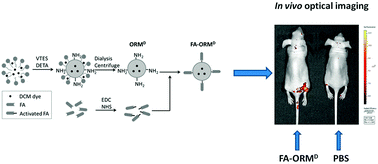Folic acid-conjugated organically modified silica nanoparticles for enhanced targeted delivery in cancer cells and tumor in vivo†
Abstract
In this work, we report the synthesis of dye-loaded and folic acid (FA)-conjugated organically modified silica (ORMOSIL) nanoparticles as targeted optical nanoprobes for in vitro and in vivo imaging. The dye-loaded ORMOSIL (ORMD) nanoparticles are synthesized by a facile aqueous phase (oil-in-water microemulsion) approach and they have an average size of 30 nm. We observed that the functionalization of FA onto the particle surface led to a strong cellular uptake of FA-conjugated ORMD nanoparticles for pancreatic cancer Miapaca-2 cells and hepatoma SMMC7721 cells with FA receptor overexpression. Such a trend is not observed for 293T cells and breast cancer MCF7 cells as these cells possess low-expression of the FA receptor. The in vivo imaging studies demonstrate that FA-ORMD nanoparticles are preferentially accumulated in tumor sites. Histological studies reveal that no-ill effects are observed in the major organs of treated mice when compared to the untreated ones. Because of the facile synthesis process, high specificity for tumor targeting and low toxicity of FA-ORMD nanoparticles, significant potential for early-cancer detection application is expected.


 Please wait while we load your content...
Please wait while we load your content...